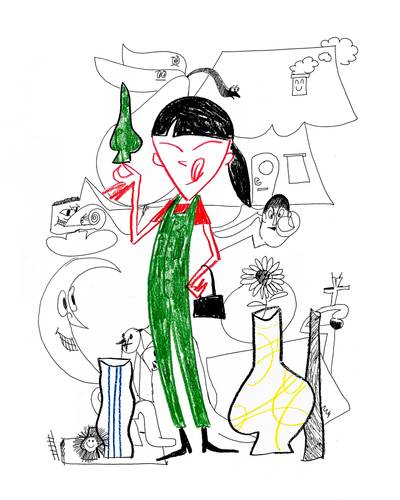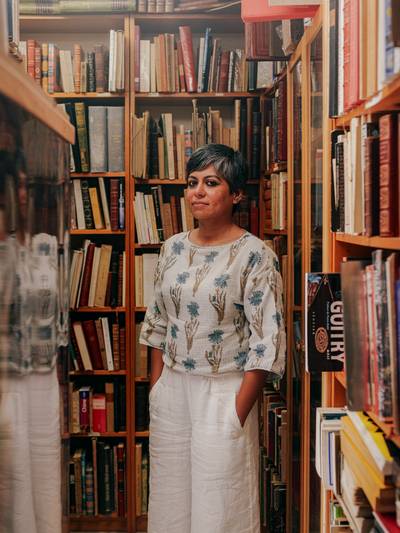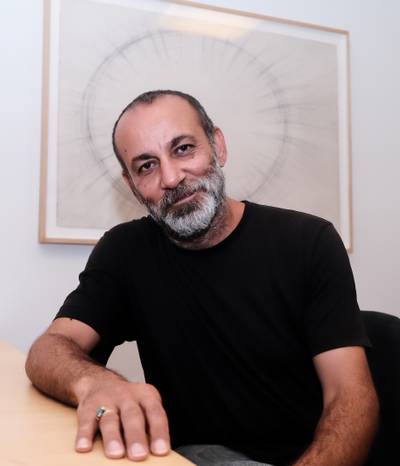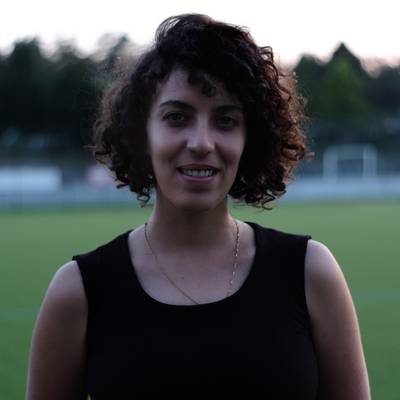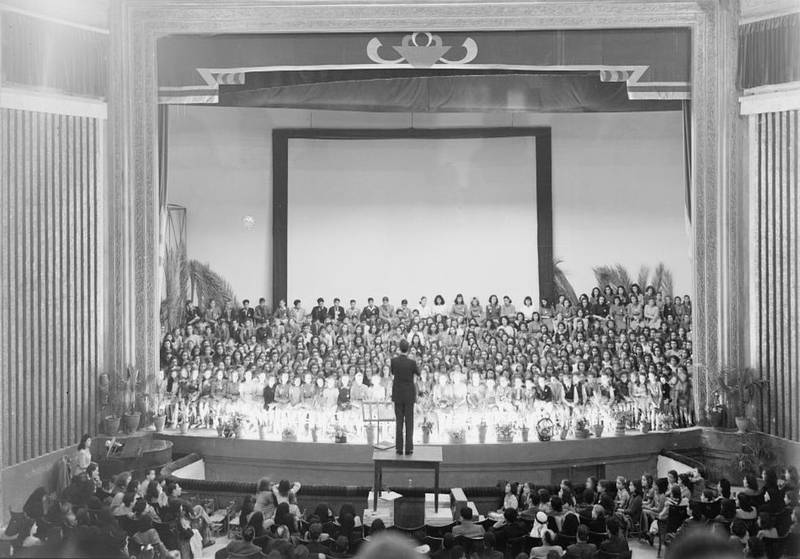

Al Hamra Cinema, Yafa, 1940s
Shayma Nader is a curator and researcher born in Jerusalem. Her research focuses on anticolonial, antidisciplinary and land-centered imaginaries and practices. She is currently a PhD candidate in artistic research at ARIA at Sint Lucas School of Arts (KdG) and University of Antwerp.
Miia Laine is a Helsinki-based radio producer, DJ, and cultural worker. Coming from a social science and ethnomusicology background, her work seeks to critically examine and redress existing power dynamics through people’s stories. She curates Sonic Club, a gathering and lecture-series on sound, music and people.
After decades of working as an art producer and choreographer with a focus on folklore, Nader Jalal started to wonder what the pre-1948 music scene in Palestine looked like beyond folk music, as there was hardly any knowledge about Arabic music or professional musicians and ensembles from this time. This interest led Nader to years of research and rediscovering a rich musical history, as well as founding the Ramallah-based Palestinian Institute for Cultural Development, Nawa, in 2008. In 2023, Nader published his first book, “Palestine in the Arab Musical Renaissance, 1900s - 1950s”.
On June 1, 2024, Nader gave a presentation at Museum of Impossible Forms, Helsinki, after which this interview was recorded. Nader is interviewed by his daughter Shayma Nader and Miia Laine on a sunny afternoon on Suomenlinna.
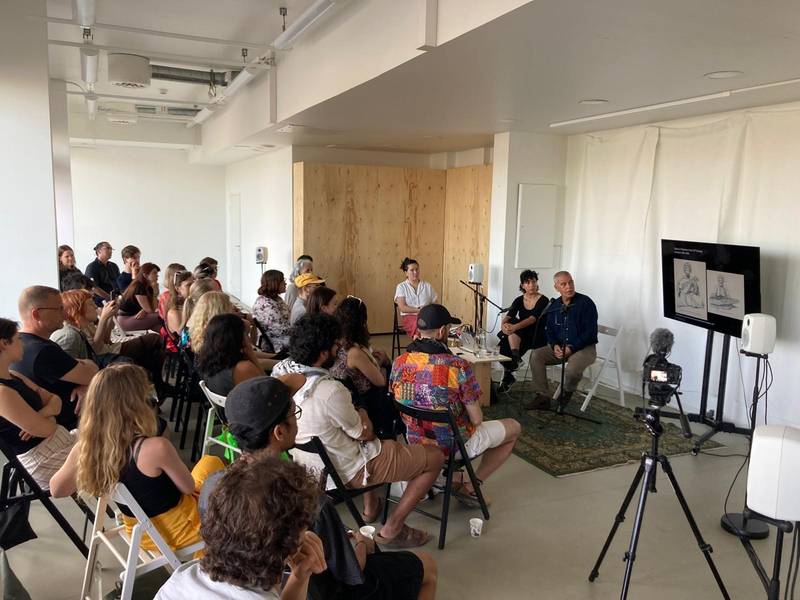

Music In Palestine Pre-1948 | Nader Jalal, at Museum of Impossible Forms, 2024.
MIIA: How did the Nawa project start, and what made you decide to research music from Palestine pre-1948?
NADER: For many years, I was involved in folklore music, and I was invited to conferences in the Arab world to talk about songs, music and dancing from Palestine. At those conferences, some colleagues asked me if we had other kinds of music or cultural expressions, something I didn’t know the answer to – like most Palestinians and Arabs. So that question began to grow in my mind, and I wanted to find out more. I knew it was going to be a huge project. I started the research in 2008, when I was Director General of Arts in the Ministry of Culture. Some of the first resources I found were an article by Elias Sahhab about Palestinian radios before 1948 and a book on Palestinian folk music by Yusra Jawhariyyeh Arnita1 from 1968. I decided to leave the ministry and start this research to search for Arabic music in Palestine and to find out where Palestine was in the Arabic music Renaissance2 before 1948.
SHAYMA: How did you conduct the research?
One of the names mentioned in Yusra’s book was Rawhi al-Khammash, an oud player and singer from Nablus who started playing in 1932 when he was eleven years old and became very famous as he travelled across Palestine to perform. I started my research with him. I found a friend of his who was still alive at the time, Ghanem Haddad, an Iraqi musician who lived in Amman. I visited him, and he told me a lot about Rawhi’s life after leaving Palestine and how he established a musical ensemble called Khumasi Baghdad.
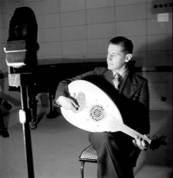

Rawhi Al-Khammash
Years of this work involved conducting interviews, which led me on a long journey of research between Egypt, Lebanon, Jordan, Syria, Iraq and Palestine. Each interview gave me new information as well as led to new people to talk to, musicians’ families or collectors, discovering vinyl records or pictures, which helped me piece together the information.
I was also able to access some of the radio archives in Baghdad and Beirut, where they found hundreds of recordings of Palestinian musicians and were able to send digitised audio files to me.
On top of the interviews, I used the few articles that existed on this topic, memoirs and autobiographies of historians, poets and musicians3, the catalogues of record companies and decades of newspaper archives for the research.
SN: How many newspapers existed in Palestine during the first half of the 20th century? And what happened to them?
More than one hundred. Not all of them were active the whole time, from 1908–1948. The Falastin newspaper, the main newspaper, started in 1911 and continued until 1948. Before 1948, each newspaper in Palestine had to send a copy to a mandate government department for archiving. After the occupation of Palestine in 1948, the Israeli military took all the copies of the newspapers that were published between 1908 and 1948, and they were kept secret in the Israeli National Library until 2019, when they released them. I found a huge amount of information in them. For example, I knew about Rajab al-Akhal and that he was a singer, but I didn’t know that he sang at Abu Shakoosh Cafe in Yafa on this Monday of that year. So together with three colleagues at Nawa, we spent more than two years going through newspaper clips and gathering and classifying information about musicians.
SN: What were some of the earliest discoveries you made?
We don’t have much information about the music in Palestine before 1900. But I found a book by an English bishop called William M. Thomson4. He was in Jerusalem in 1850, and he saw a music band—we call it Takht in Arabic music—and made drawings of the musicians. From these drawings, we can see people playing qanun and oud in one of the Jerusalem cafes in 1850. And he wrote that he heard them playing instrumentals. We were mistaken in Palestine; we thought that all of our music is singing. But Thompson said that he heard instrumentals in 1850, which means that the Palestinians had music that we don’t know about. There are no documents or archives we know of.
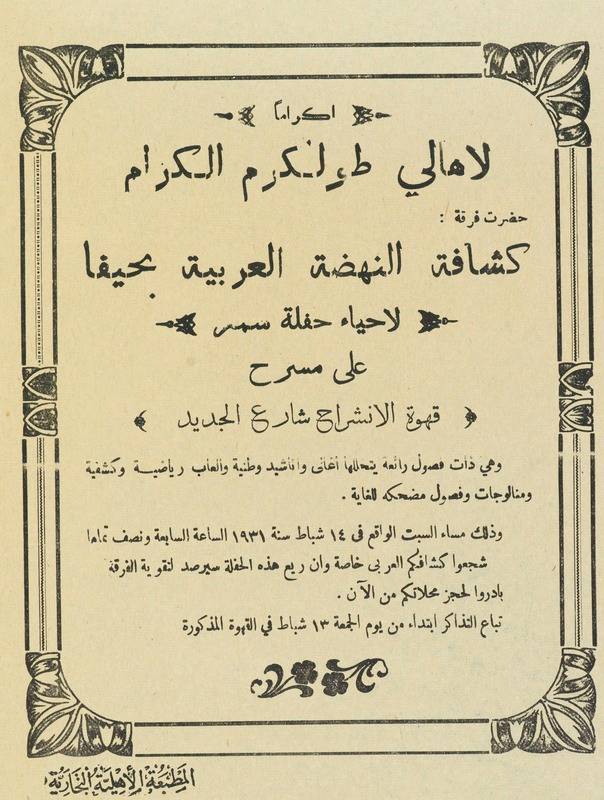

Concert advert for Al Inshirah Cafe, 1931
Also, in 1893, there was a World Exposition in Chicago and Abu Khalil al Qabbani, a famous Syrian singer, musician and director was invited to perform. He said that when he had the invitation, he started to think about musicians to bring, and he chose musicians from Jerusalem, Nazareth, and Bethlehem, the cities in Palestine. And then Damascus, Beirut. And we know some of them who went, Mary Dahdouh and her husband Elias Qattan from Bethlehem, and Ibrahim al-Qabbani from Yafa.
So these examples tell us a little bit about the musical life in Palestine in the 19th century. If you look at the map of Palestine, it’s in the middle of the Arab world. We know the Arabic Renaissance happened in Cairo and Aleppo, and Palestine was in the middle. So the musicians had to travel from Egypt to Syria through Palestine. It was easy for musicians to move between Syria, Palestine and Egypt, both during the Ottoman Empire as well as after, with the French in Syria and the English in Palestine and Egypt. There were many music venues in the cities, cafes and later theatres and cinemas where musicians performed, including local musicians as well as touring musicians. We know of big stars such as Mohammed Abdel Wahhab, Umm Kulthum, Munira al-Mahdiyya, Mohammed Abdel Mutalleb and many others who all came to Palestine to perform.
ML: What were the different parts of the music industry in Palestine, and how did they develop over time?
I like to look at the music industry in Palestine through three different elements that all interact with each other. The live music, the vinyl records, and the radio stations. Vinyl production started at the beginning of the century and continued throughout the 1930s and 1940s. People would gather in cafes in the cities and villages to listen to them, and they were played on the radio as well. The record labels active at the time were Baidaphon in Beirut and Victor, which was part of Gramophone. We know from their catalogues that they made hundreds of vinyl records of Palestinian musicians, and so far we have only found a fraction of them.
Live music happened in cafes, theatres and cinemas. The performances of Palestinian musicians or Arab musicians started from before the 20th century, I think, because Abu Khalil Qabbani came to Palestine in 1901 and I’m sure that there were many others before him, but we don’t have resources. The third element is the music in the radios in the thirties, where both records and live music were played.
In all of these parts, we can see a clear growth in the first half of the 20th century. For example, in the newspapers, I found three concerts advertised in Yafa in 1909, but in 1925, we already found 25 concerts.
And the bands that held concerts in Yafa started with five musicians before WWI, but in the thirties and forties, there were sixty members in the band. Which means there was a need to expand the theatres; they started to build more cafes and wider and bigger theatres. And in the thirties, they started to build cinemas because maybe they found a market for this kind of investment. So they established many cinemas, such as Al-Quds al-Kabeer Cinema in Jerusalem; al-Hamra and Nabil Cinemas in Yafa; and al-Burj and al-Zahra Cinemas in Akka. There were big concerts and festivals for all the students from Palestine, Syria and Lebanon held in many cities, including Yafa and Jerusalem.
SN: Can you tell us more about the radio stations?
The first radio in the Arab world was established in Egypt in 1934. The first radio in Palestine, Huna Al-Quds, the Jerusalem Calling Radio, was established only two years later, in 1936, by the British Mandate. The radio was broadcasting in three languages: Arabic, Hebrew and English. The British claimed they were doing it for the Palestinians, but it was during the lead up to WWII that they were trying to gain influence over the people. It also happened during the Palestinian Great Revolt and strike between 1936-1939, when Palestinians fought for independence and against the establishment of a national home for Jews in Palestine. But despite the political reasons for the radio’s existence, it was a very important place for music in Palestine. It attracted many musicians, authors, and producers from Palestine, Egypt, Lebanon, Syria, Iraq and Sudan. There were different Huna al-Quds bands. Some of their members went to study at the Fouad al-Awwal Conservatory in Cairo and returned to perform in Palestine.
The second station, the Near East Broadcasting Station in Yafa, was broadcasting in Arabic. It was established by the British government in 1941 during WWII and so it was controlled by the British Foreign Office. It was founded as a reaction to Radio Bari in Italy, which was broadcasting fascist propaganda for Arab listeners as part of the war. More musicians started to work in the radio and they made many productions. But unfortunately, there are not many recordings left from the radios because they produced them live.
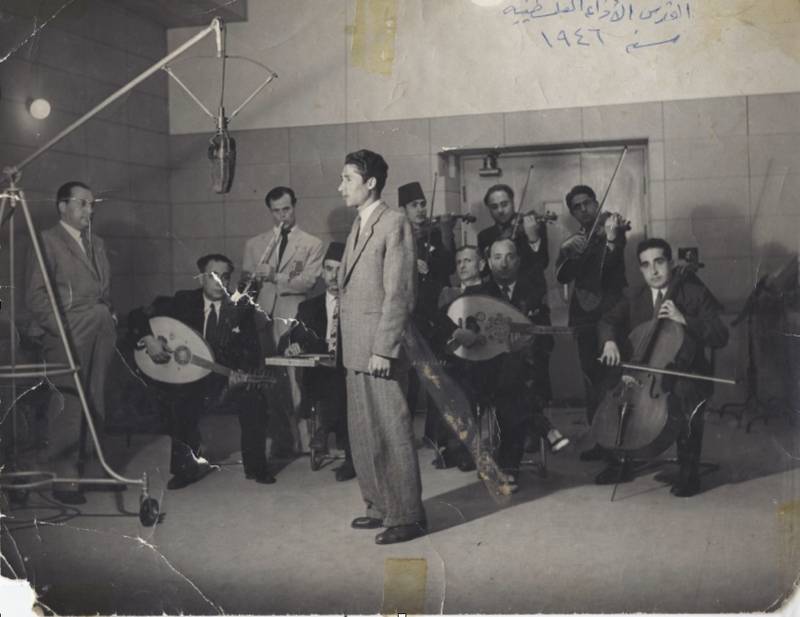

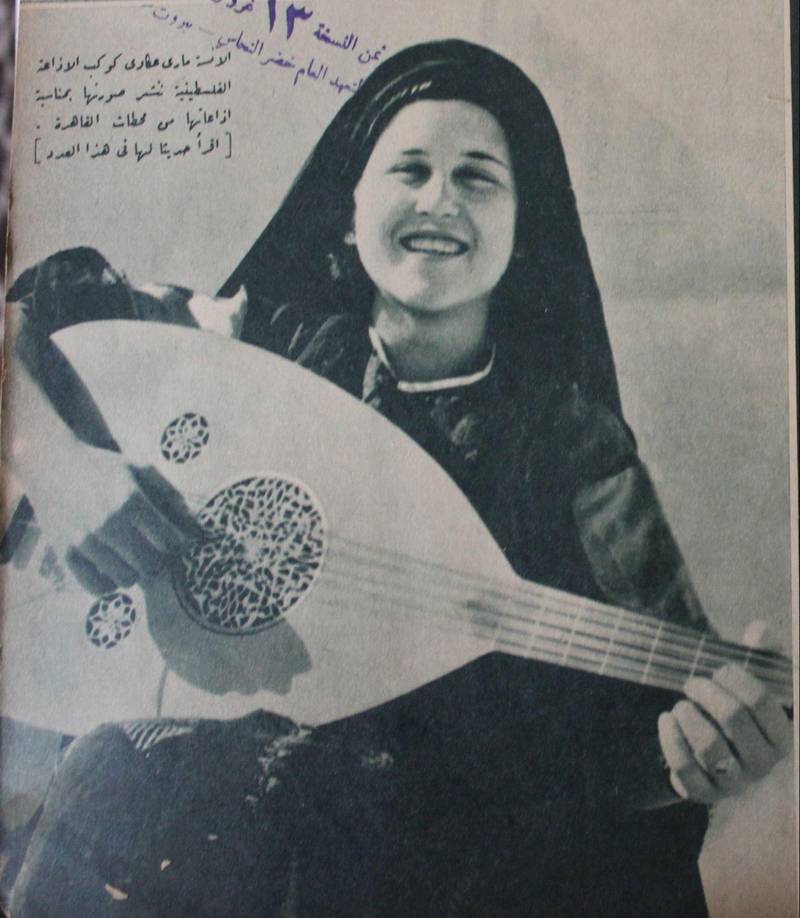

Mohamad Ghazi, This is Jerusalem Radio, 1946
Mary Akkawi, This is Jerusalem Radio, 1930s
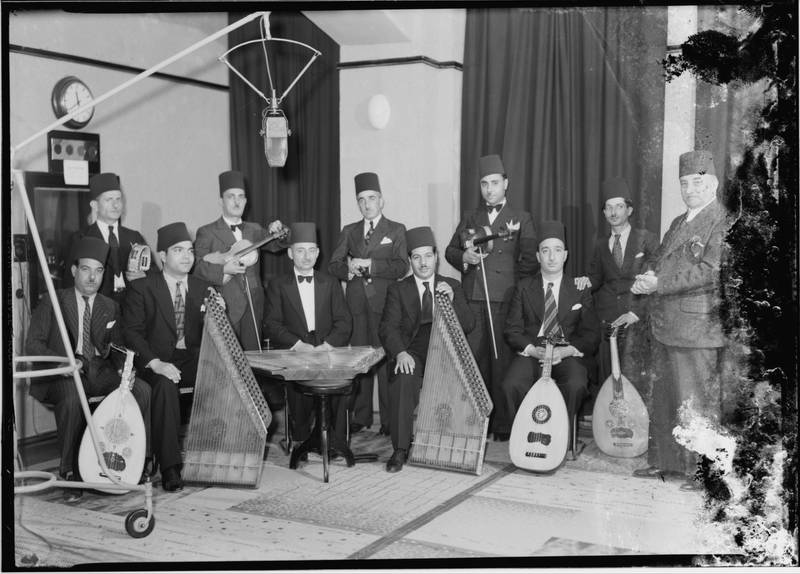

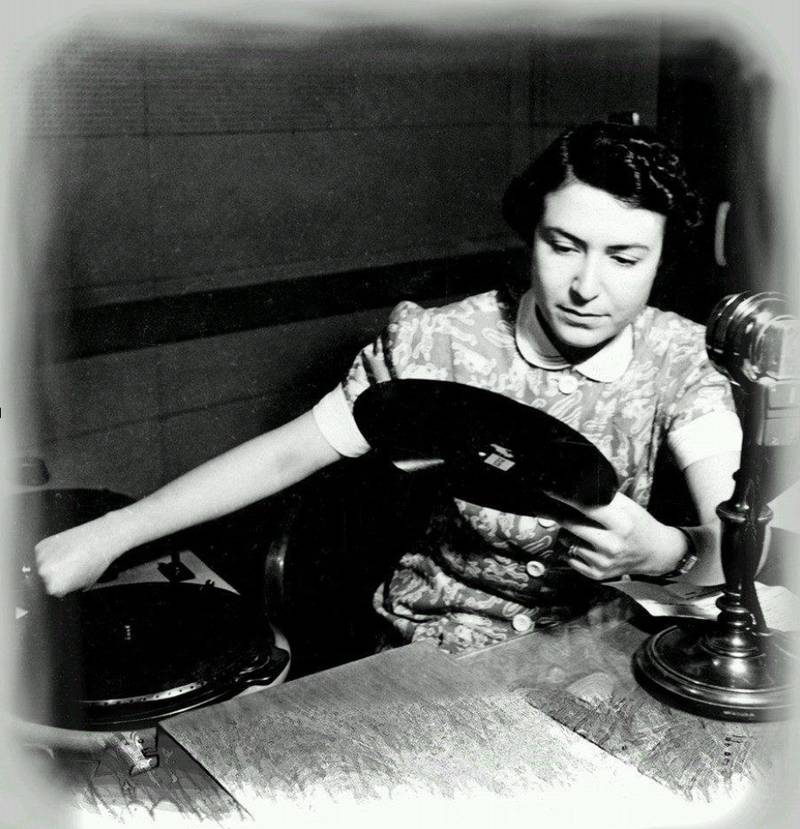

This is Jerusalem Radio Band
Asma Tobi, radio presenter, early 1940s
ML: We now have an idea of what it was like before 1948—this very vibrant musical life. There is a lot of travelling, freedom of movement, concerts, inspiration and interaction across the whole region. What happened to the music scene after the Nakba?
The Nakba was a major turning point. The radios either closed or moved. The Israeli army took the Jerusalem radio building, established an Israeli radio in it, and stole most of the archives. They are scattered somewhere between the National Library of Israel, the Israeli army archives, and Israeli universities. Near East Radio moved to Cyprus, and their archive went to the BBC, parts of which I was able to access.
And for what happened to the musicians, each of them has a different story. The occupation displaced and dispersed musicians, producers, and technicians in the Arab world and beyond. Part of the Huna al-Quds Radio cast moved to Syria like Yahya al-Saudi, Riyad al-Bandak and Youssif Batrouni; others moved to Lebanon, such as Mohammed Ghazi, Hanna and Farid al-Salfiti etc. Some moved to Ramallah, then Amman, in 1959 and joined the Jordanian radio station. As for the team of the Near East Radio Station, they moved to Cyprus following the Nakba until 1956. After the 1956 War against Egypt, the team resigned and most of them moved to Beirut.
Some musicians stopped playing after 1948. For example, Michel Karkar and his brother used to play violin and cello. In 1948, their father died and they both had to stop playing music and find jobs to feed the family.
I can imagine the priorities in life changing after the Nakba. They would not think about the music venue in Yafa under these conditions. They would think about how to start building their life again after it was destroyed in one place before returning to music. It’s a big issue. We are witnessing another genocide in Gaza, similar to al-Nakba. I have a musician friend in Gaza who I have called a few times. He said, “We are moving under bombing from one place to another.” Do you think he is thinking about composing music now? He’s thinking of his brothers, his mother, where to take them, and what to eat.


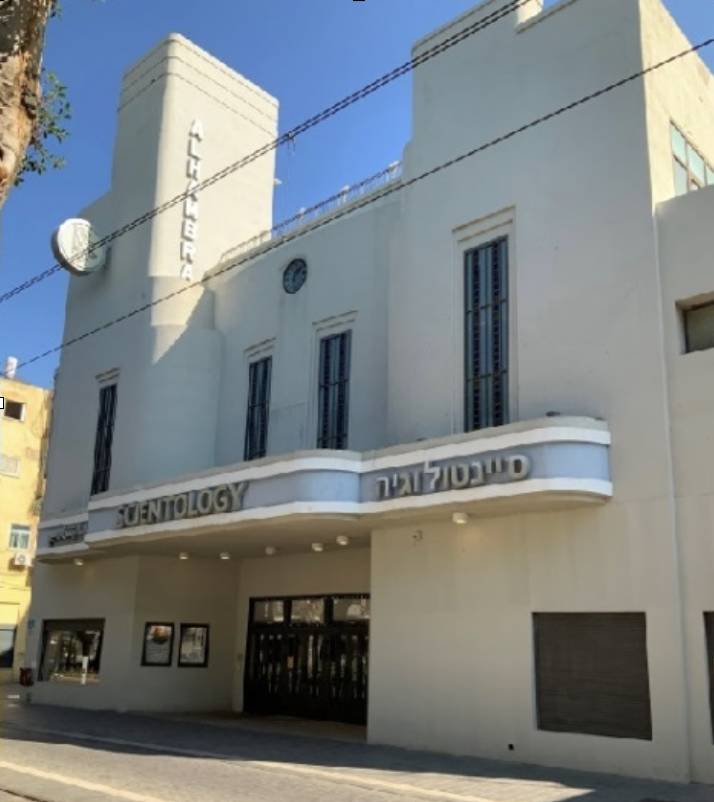

Al Hamra Cinema, Yafa, 1937
Center of Scientology, former Al Hamra Cinema, 2022
ML: We have now been mostly talking about Arabic Classical music in Palestine. Did you find out about other genres, seeing as there were many different groups and immigrants present in Palestine? How did all of these people influence the music scenes?
In this interview, I mostly talked about Arabic Classical music, but we had many other genres. Of course, all the different people influenced the music in different ways, and there is a lot we don’t know yet; the research is ongoing. Different communities played together, and concerts were organised for charities, for example, to support the construction of a tuberculosis hospital in Lebanon, the victims of an earthquake in Nablus, the martyrs families in Libya and Palestine, etc. The colonial missionary schools also influenced the music, as they encouraged people to play Western music. This is such a hugeproject,t and we will hopefully be able to get a better picture of everything in the future.
In my research, I don’t talk about “Palestinian music.” I always say “music in Palestine”. For example, there is a musician called Halim el-Roumi. Today there is a discussion about whether he was Palestinian or Lebanese. Back then, it was much easier to move between Beirut and Haifa; there were no borders. So I don’t care whether Halim el-Roumi was Lebanese or Palestinian. He was playing music in Palestine.
SN: After the Nakba, there was this period in which we don’t know much about the musical life in Palestine because the musicians were displaced. It was a moment of crisis and survival, and now we’re trying to remember and restitch this past. Why do we need to archive? Why do we need to remember, and why do we need to revive this heritage? Why are you doing this, this archiving?
It’s a question of responsibility and beauty. This collective memory was destroyed in 1948. The Israelis stole many things and started to tell the world that they were the owners of this narrative. It is very important and part of the national responsibility, that those musicians have a right to be respected for their role, their productions, and their raising the name of Palestine at that time.
When the Nakba happened, they cut Palestine off from the Arab world. We want to reattach it. Not to prove that Palestinians are better than others. But to prove that we are part of this existing Arabic culture, which the occupation wants to erase.
And by beauty, I mean that some of these productions were of very high quality. Part of the project has been reproducing the music, we have given many concerts and recorded four albums for eight of these Palestinian composers with different ensembles, so people can hear it again. We want to re-introduce this beautiful music, of which we have sometimes only found the sheet music. We chose the best instrumentals and Muwashshahat5 for Rawhi al-Khammash. And the best songs of Mohammad Ghazi, Abdul Karim al-Qazmouz, Riyad al-Bandak and others.
Could you imagine if somebody stole all the records of Tchaikovsky? We have the right as people to hear it. Because it’s not for you; it’s for the world. The same thing is true for Rawhi and the musicians of Palestine. They are part of world production. And there is no right for the occupation to deny it, delete it or hide it. In our project, we are saving it and giving it to the present and coming generations so they can build on it. The new generations should know about their grandmothers and grandfathers, and they should know, not only about the music, but also that they have a rich heritage.
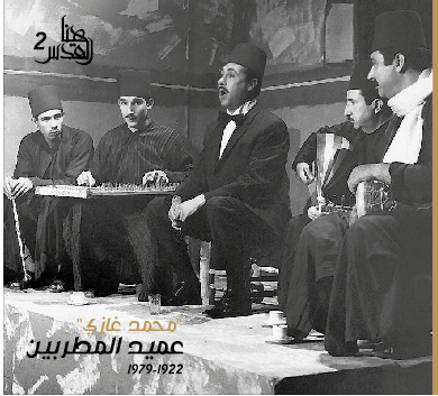

](/images/lp1L8OfiGv-800.jpeg)
](/images/zNr7g4A4tL-32.webp)
